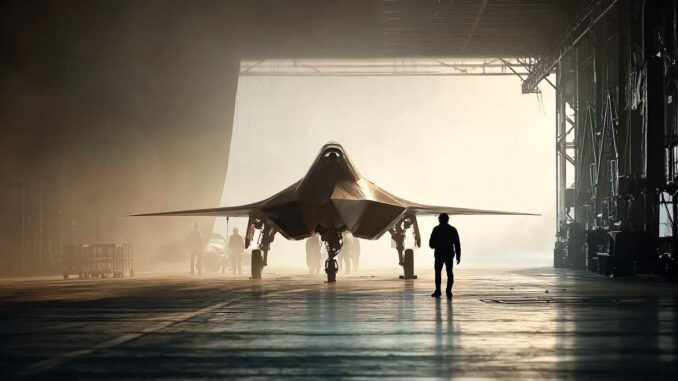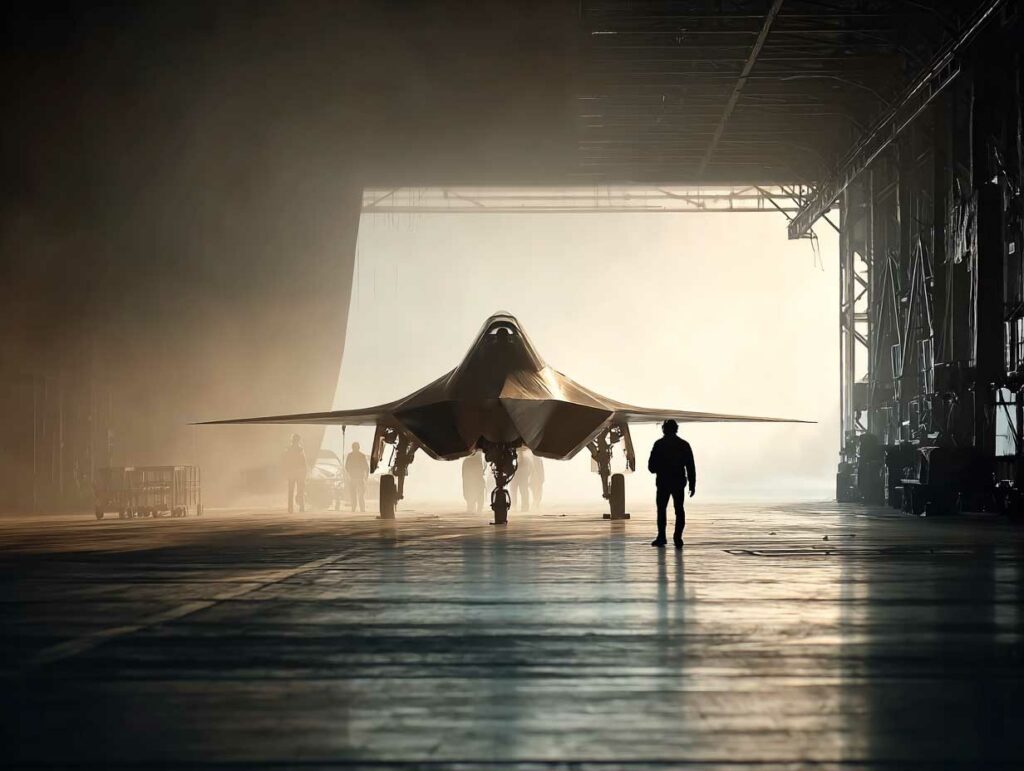
The F-47, a sixth-generation fighter jet developed by Boeing, confirms American dominance over China in the race for advanced combat aircraft.
On June 25, 2025, US President Donald Trump confirmed that Boeing had been selected to lead the development of the future sixth-generation fighter jet, designated F-47. This strategic contract is part of the Next Generation Air Dominance (NGAD) program, intended to succeed the F-22 Raptor. According to unofficial information, an experimental version has already been flying for several years in the Nevada desert. Its first public appearance is said to have taken place discreetly at the Paris Air Show, held from June 16 to 22, 2025.
This technological and political choice puts the United States in a position of technological superiority over the efforts of China (J-XX or J-25) and European projects (SCAF/FCAS). The F-47 is said to be an aircraft focused on absolute stealth, human-machine integration, partial autonomous flight, and the ability to coordinate a swarm of drones.
The contract won by Boeing is worth more than €12 billion for the first phase, covering prototypes, initial industrialization, and systems architecture. The F-47 is not just a fighter: it is an interconnected platform designed to survive in highly contested environments saturated with air defenses.
The NGAD program and the award of the contract to Boeing
The NGAD program was launched in 2016 by the US Air Force to anticipate the end of the operational life of the F-22 Raptor, which entered service in 2005. This program aims to produce a complete air combat system, with a 6th generation fighter jet at the heart of a network of sensors, satellites, drones, electronic warfare systems, and ground stations. The goal is to ensure US air superiority by 2040.
The choice of Boeing in 2025 is strategic. Since the withdrawal of the F-22 (Lockheed Martin) and criticism of the F-35’s cost of ownership, the Pentagon has been looking to diversify its industrial partners. Boeing, which already manufactures the F-15EX and MQ-25 drones, is regaining a central role in combat aviation.
The contract awarded to Boeing includes:
- Development of the F-47 prototype
- Manufacturing the first series of validation aircraft
- Integration into C3I (command, control, communications, computing, and intelligence) platforms
- Coordination with unmanned systems (CCAs)
The initial budget, approved by Congress, is around $13 billion, or approximately €12.2 billion. This is the most ambitious program since the F-22, with a projected total cost of up to €250 billion if all options are exercised.
The production of the F-47 is accompanied by a “transformation of air doctrines” component, particularly regarding the use of artificial intelligence for mission sharing between human pilots and drones.
Expected characteristics of the F-47 fighter jet
The F-47 is designed to meet the criteria established for sixth-generation combat aircraft, breaking with the logic of fifth-generation aircraft. While very little data is officially available, several technical elements are expected or confirmed by industrial leaks and budget documents.
Technical specifications are expected to include:
- An ultra-stealth airframe, optimized for a radar signature of less than 0.001 m²
- Supersonic flight capability without afterburners (supercruise) beyond Mach 1.6
- Native AI integration for mission management, threat detection, and trajectory optimization
- Multispectral sensor fusion: infrared, LPI radar, optronics
- A modular internal bay capable of carrying long-range air-to-air missiles (AIM-260 JATM), SDB bombs, or kamikaze drones
- A human-machine interface with enhanced visual display (AR helmet), voice commands, and decision support
The F-47 would be compatible with loyal wingman drones, piloted from the aircraft itself. These unmanned vehicles could carry weapons, conduct reconnaissance, or act as electronic decoys.
Autonomy, active stealth, and mission decentralization are at the heart of the F-47’s architecture. Ultimately, it could even operate unmanned in semi-autonomous combat mode in congested environments, such as the early stages of a conflict with China over the Pacific.

Technological competition with China and strategic challenges
The development of the F-47 responds to an imperative to maintain air superiority in the face of China‘s growing military power. The Chinese J-XX or J-25 program, about which little is known, is believed to be at an earlier stage but to have significant resources at its disposal. Beijing is investing heavily in stealth, military AI, and network warfare (cyber, quantum, denial of access). Demonstrators visible in 2024 show a twin-engine stealth platform, probably derived from the J-20.
The United States believes that the early 2030s will be marked by indirect air confrontation, where systems must be able to survive electromagnetic saturation, hypersonic missiles, and multi-layered denial of access. The F-47 aims to neutralize these threats by maintaining information superiority: it is no longer just a matter of maneuvering or firing faster, but of organizing distributed combat, where each platform is an intelligent node.
The F-47 is expected to be deployed primarily at forward bases in the Pacific, such as Guam, Okinawa, or possibly Palau. It could also be integrated into deterrence plans against China’s A2/AD (anti-access/area denial) strategy by neutralizing long-range radars and S-400 or HQ-9 systems.
Washington also anticipates growing demand from its strategic partners: the United Kingdom, Japan, Australia, and even NATO. However, the F-47 may not be exported in its full version, or only in a limited version, as was the case with the F-22.
The industrial and operational consequences of choosing the F-47
The F-47 contract repositions Boeing as a key player in the US defense industry. After a decade marked by partial failures (KC-46, Starliner), the company is now taking on a major role in the design of the 21st century fighter jet. The likely production site is St. Louis, with a network of subcontractors spread across Texas, California, and South Carolina.
This program is expected to generate more than 12,000 direct jobs and up to 40,000 indirect jobs over the first two decades. It also involves a review of training standards for pilots, drone operators, and military engineers, due to the shift to hybrid human/machine piloting.
The US Air Force plans to integrate approximately 200 to 300 F-47 units initially, with a shared logistics budget with the CCAs drones. The cost per unit is estimated at more than $250 million, excluding support. By way of comparison, the F-22 cost around $180 million and the F-35 around $90 million.
The F-47 will serve as a test bed for future distributed air combat technologies. The spin-offs are expected to influence European (SCAF), Japanese (FX) and Korean (KF-XX) choices. NATO standardization could be disrupted if the F-47 imposes its protocols, network architectures and active stealth standards.
War Wings Daily is an independant magazine.